A) liquid water
B) crystals grown in a laboratory
C) volcanic glass
D) piece of wood
E) all of these
G) C) and E)
Correct Answer

verified
Correct Answer
verified
Multiple Choice
From the list provided below,choose those observations that accurately describe the mineral presented in this image. 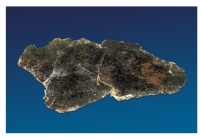
A) This mineral displays one direction of cleavage.
B) This mineral displays three directions of cleavage.
C) This mineral has a conchoidal fracture.
E) All of the above
Correct Answer

verified
Correct Answer
verified
Multiple Choice
In this part of the Periodic Table,what type of elements are in the group that includes elements Cu,Ag,and Au? 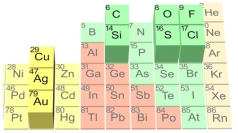
A) metals
B) nonmetals
C) noble gases
D) silicates
F) A) and C)
Correct Answer

verified
Correct Answer
verified
Multiple Choice
Which of the following is a dark-colored silicate mineral?
A) quartz
B) potassium feldspar
C) muscovite
D) biotite
E) none of these
G) A) and E)
Correct Answer

verified
Correct Answer
verified
Multiple Choice
Which of these minerals would you use to make wallboard for the interior walls of your house?
A) calcite
B) gypsum
C) quartz
D) hematite
E) clay minerals
G) C) and D)
Correct Answer

verified
Correct Answer
verified
Multiple Choice
What causes a water molecule to be polar?
A) the magnetic properties of oxygen
B) the magnetic properties of hydrogen
C) the position of the hydrogen atoms on one side of the molecule
D) the abundance of ice in the north and south polar regions
F) A) and C)
Correct Answer

verified
Correct Answer
verified
Multiple Choice
This figure illustrates the average abundance in: 
A) Earth's crust
B) oceanic crust only
C) continental crust only
D) the entire earth
E) the universe
G) B) and C)
Correct Answer

verified
Correct Answer
verified
Multiple Choice
The two elements most abundant in the earth's crust are:
A) helium and hydrogen
B) iron and magnesium
C) sodium and potassium
D) silicon and oxygen
E) iron and nickel
G) A) and B)
Correct Answer

verified
Correct Answer
verified
Multiple Choice
What type of silicate minerals is shown from this arrangement of silicon tetrahedron? 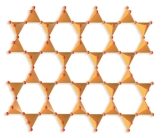
A) independent tetrahedra
B) single chains
C) double chains
D) sheets
E) frameworks
G) B) and D)
Correct Answer

verified
Correct Answer
verified
Multiple Choice
What mineral is characterized by a reddish streak,as shown in this photograph? 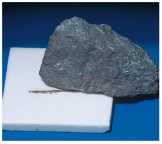
A) quartz
B) feldspar
C) calcite
D) hematite
E) magnetite
G) None of the above
Correct Answer

verified
Correct Answer
verified
Multiple Choice
Which layer in the earth has a composition similar to the meteorite shown in this photograph? 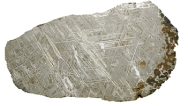
A) continental crust
B) oceanic crust
C) mantle
D) core
F) All of the above
Correct Answer

verified
Correct Answer
verified
Multiple Choice
Which of the following is true about rocks and minerals?
A) a rock can contain more than one mineral
B) a mineral is composed of chemical elements
C) a single rock can include more than one mineral
D) all of these
F) A) and B)
Correct Answer

verified
Correct Answer
verified
Multiple Choice
Which of the following is true about asbestos?
A) There are several types of asbestos,but they represent the same mineral.
B) Different types of asbestos have the same health risks.
C) Each type of asbestos has long,straight fibers.
D) Asbestos represents different minerals with different health risks.
F) A) and C)
Correct Answer

verified
Correct Answer
verified
Multiple Choice
Which of the following is NOT composed of calcium carbonate?
A) calcite
B) pyrite
C) marble
D) shells
E) limestone
G) B) and E)
Correct Answer

verified
Correct Answer
verified
Multiple Choice
How do silica tetrahedra bond in silicate minerals?
A) with each other by sharing an oxygen
B) with other elements,such as potassium
C) in single or double chains
D) in sheets
E) all of these
G) A) and D)
Correct Answer

verified
Correct Answer
verified
Multiple Choice
This iron oxide mineral commonly has a reddish color and consistently has red streak.What mineral is it? 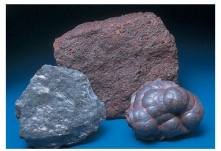
A) calcite
B) dolomite
C) hematite
D) magnetite
E) pyrite
G) All of the above
Correct Answer

verified
Correct Answer
verified
Multiple Choice
What type of cleavage is illustrated in this figure? 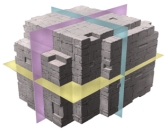
A) one direction
B) two perpendicular directions
C) two nonperpendicular directions
D) three perpendicular directions
E) three nonperpendicular directions
G) C) and D)
Correct Answer

verified
Correct Answer
verified
Multiple Choice
Which of the following is a mineral?
A) ice
B) crystals grown in a laboratory
C) volcanic glass
D) material with crystals of different chemical compounds
E) none of these
G) A) and B)
Correct Answer

verified
Correct Answer
verified
Multiple Choice
The mineral shown in this photograph is a sulfide mineral and commonly forms cube-shaped crystals.What mineral is it? 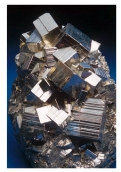
A) pyrite
B) hematite
C) dolomite
D) gypsum
E) halite
G) B) and E)
Correct Answer

verified
Correct Answer
verified
Multiple Choice
The three elements most abundant in the entire Earth are:
A) sulfur,oxygen,helium
B) helium,hydrogen,oxygen
C) aluminum,potassium,sodium
D) iron,oxygen,silicon
E) hydrogen,helium,and argon
G) B) and D)
Correct Answer

verified
Correct Answer
verified
Showing 41 - 60 of 107
Related Exams